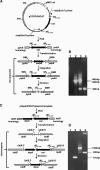An efficient method of selectable marker gene excision by Xer recombination for gene replacement in bacterial chromosomes
- PMID: 16597952
- PMCID: PMC1449051
- DOI: 10.1128/AEM.72.4.2520-2525.2006
An efficient method of selectable marker gene excision by Xer recombination for gene replacement in bacterial chromosomes
Abstract
A simple, effective method of unlabeled, stable gene insertion into bacterial chromosomes has been developed. This utilizes an insertion cassette consisting of an antibiotic resistance gene flanked by dif sites and regions homologous to the chromosomal target locus. dif is the recognition sequence for the native Xer site-specific recombinases responsible for chromosome and plasmid dimer resolution: XerC/XerD in Escherichia coli and RipX/CodV in Bacillus subtilis. Following integration of the insertion cassette into the chromosomal target locus by homologous recombination, these recombinases act to resolve the two directly repeated dif sites to a single site, thus excising the antibiotic resistance gene. Previous approaches have required the inclusion of exogenous site-specific recombinases or transposases in trans; our strategy demonstrates that this is unnecessary, since an effective recombination system is already present in bacteria. The high recombination frequency makes the inclusion of a counter-selectable marker gene unnecessary.
Figures



Similar articles
-
Identification and characterization of the dif Site from Bacillus subtilis.J Bacteriol. 2001 Feb;183(3):1058-68. doi: 10.1128/JB.183.3.1058-1068.2001. J Bacteriol. 2001. PMID: 11208805 Free PMC article.
-
The ripX locus of Bacillus subtilis encodes a site-specific recombinase involved in proper chromosome partitioning.J Bacteriol. 1999 Oct;181(19):6053-62. doi: 10.1128/JB.181.19.6053-6062.1999. J Bacteriol. 1999. PMID: 10498718 Free PMC article.
-
FtsK-dependent and -independent pathways of Xer site-specific recombination.EMBO J. 1999 Oct 15;18(20):5724-34. doi: 10.1093/emboj/18.20.5724. EMBO J. 1999. PMID: 10523315 Free PMC article.
-
[Progress on XerCD/dif site-specific recombination].Yi Chuan. 2012 Aug;34(8):1003-8. doi: 10.3724/sp.j.1005.2012.01003. Yi Chuan. 2012. PMID: 22917905 Review. Chinese.
-
A tale of two genomes: resolution of dimeric chromosomes in Escherichia coli and Bacillus subtilis.Res Microbiol. 2000 Sep;151(7):503-11. doi: 10.1016/s0923-2508(00)00220-5. Res Microbiol. 2000. PMID: 11037128 Review.
Cited by
-
Advances on systems metabolic engineering of Bacillus subtilis as a chassis cell.Synth Syst Biotechnol. 2020 Jul 29;5(4):245-251. doi: 10.1016/j.synbio.2020.07.005. eCollection 2020 Dec. Synth Syst Biotechnol. 2020. PMID: 32775709 Free PMC article.
-
Multiple integration of the gene ganA into the Bacillus subtilis chromosome for enhanced β-galactosidase production using the CRISPR/Cas9 system.AMB Express. 2019 Sep 30;9(1):158. doi: 10.1186/s13568-019-0884-4. AMB Express. 2019. PMID: 31571017 Free PMC article.
-
The dif/Xer recombination systems in proteobacteria.PLoS One. 2009 Sep 3;4(9):e6531. doi: 10.1371/journal.pone.0006531. PLoS One. 2009. PMID: 19727445 Free PMC article.
-
Xer recombination for the automatic deletion of selectable marker genes from plasmids in enteric bacteria.Synth Biol (Oxf). 2022 May 13;7(1):ysac005. doi: 10.1093/synbio/ysac005. eCollection 2022. Synth Biol (Oxf). 2022. PMID: 35601876 Free PMC article.
-
Microbial Proteases Applications.Front Bioeng Biotechnol. 2019 Jun 12;7:110. doi: 10.3389/fbioe.2019.00110. eCollection 2019. Front Bioeng Biotechnol. 2019. PMID: 31263696 Free PMC article. Review.
References
-
- Chalker, A. F., A. Lupas, K. Ingraham, C. Y. So, R. D. Lunsford, T. Li, A. Bryant, D. J. Holmes, A. Marra, S. C. Pearson, J. Ray, M. K. Burnham, L. M. Palmer, S. Biswas, and M. Zalacain. 2000. Genetic characterisation of Gram-positive homologs of the XerCD site-specific recombinases. J. Mol. Biotechnol. 2:225-233. - PubMed
-
- Cooke, G. D., R. M. Cranenburgh, J. A. J. Hanak, P. Dunnill, D. R. Thatcher, and J. M. Ward. 2001. Purification of essentially RNA free plasmid DNA using a modified Escherichia coli host strain expressing ribonuclease A. J. Biotechnol. 85:297-304. - PubMed
Publication types
MeSH terms
Substances
LinkOut - more resources
Full Text Sources
Other Literature Sources
Molecular Biology Databases

